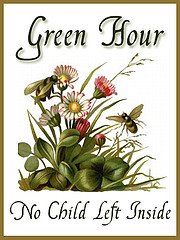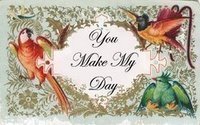 Photocredit:Nova
Photocredit:NovaI’ve always been a total book worm – and I know in blogland that puts me in good company. Knowing the immense pleasure that reading gives me, a love of books is right at the top of my list of things to ‘pass on to my kids’. Actually, I think every parent wants their child to develop a love of reading - but it isn’t always easy.
Developing literacy skills is pretty controversial … the spectrum ranges from the
‘teach your 3 month old to read’ to the unschooling approach where children simply learn to read in their own good time … and there is everything in the middle.
So, I’ve been puzzling over how best to tackle such a huge subject. There is so much I want to write about here. There are huge differences in approach here between Playcentre, Waldorf and Montessori to children’s literacy – in fact I would go as far as to say that this is THE area where the differences are really obvious. It is also an area where I personally disagree with the Waldorf approach, but more about that another day!
I think now is a good time to remind you all that this is a blog – not a textbook – so please see all these thoughts as just my interpretation, and feel free to debate with me in the comments! The book corner of my dreams
The book corner of my dreams
Photocredit:Rainbow MamaThe Waldorf/Steiner approachOne of the most controversial aspects of the Waldorf/Steiner approach is not teaching children to read until they are 7, or the
change of teeth. This is because, in the Steiner philosophy, children under the age of seven are still developing their physical bodies, and should not have their intellectual capacities called upon. Its not that they can’t learn to read, but Steiner considered that it was actually damaging to teach this to young children.
"It is quite possible to teach young children reading and writing by rote .. but it is also possible to deaden something in them by doing this, and anything killed during childhood remains dead for the rest of one's life" Rudolf Steiner, Waldorf education and Anthroposophy
"People will object that the children then learn to read and write too late. This is said only because it is not known today how harmful it is when children learn to read and write too soon. It is a very bad thing to be able to write early ... A child who cannot write properly at thirteen or fourteen ... is not so hindered for later spiritual development as one who early, at seven or eight years, can already read and write perfectly" Rudolf Steiner, Kingdom of ChildhoodSo in a Waldorf/Steiner kindergarten you won’t see many, if any, children’s books. You won’t see charts on the wall with the alphabet and numbers on them. You won’t see children’s names on cards for them to find and put on the attendance board. While mainstream ECE strives to be ‘print rich’, a Waldorf kindergarten is deliberately ‘print poor’.
However, Waldorf kindergartens are very rich in language and story telling. Steiner teachers are trained in therapeutic speech techniques, so you should hear teachers speaking slowly, calmly, with a particular emphasis on the vowels. They will ‘paint pictures’ with their words rather than give directions, so a jacket might be ‘crying on the floor’ rather than ordering a child to ‘pick it up’.
A daily story, which will be acted out with handmade puppets, is a key part of the kindergarten curriculum. Usually, the children will be told simple fairy tales – Steiner himself had a real thing for ‘Grimms’ – so for the kindergarten years (4-6 year olds) tales like ‘sweet porridge’ ‘the star child’ and ‘the gingerbread boy’ are common fare. Stories are repeated every day, often for weeks at a time, so that the children can really absorb the story.
Picture books are still certainly part of a Waldorf child’s life … I was told by a Steiner Association supervisor that we should ‘surround our children with books’ and that we should read to our children all the time, even when they are teenagers if they will still let us! There are many wonderful children’s books that you will see commonly recommended by Waldorf teachers and parents … I will put up a list in a future post!
PlaycentrePlaycentre, being more aligned with modern ECE approaches rather than a particular pedagogy, values and encourages the development of literay skills, but does so from a basis of free play. One of the ‘areas of play’ is the story corner, and literacy as a curriculum area is woven across the entire centre.
Playcentre mama
Mary explained the Playcentre approach to me like this
“Numeracy and literacy are dealt with holistically in each area of play. We might roll playdough snakes together and count them - 1, 2, 3, 4!. We might fly to the moon on the swings - countdown with me! 10!, 9!, 8! etc. We might ask a child if we can write their name on the top of their painting, saying the letters as we write them. The child might like to write their own name on instead. We might set up the home corner as a print-rich environment - telephone books, shopping list books with sharp, ready-to-use pencils, posters on the wall with labels at child height, drawers labeled. The carpentry area has the tools labeled, has builders' pencils and metal tape for measuring. We might make stop/go signs for the diggers in the sandpit, and build walls with blocks. If the children show an interest in extensions along these lines, the adults can go with the flow. So, you might see all sorts of stuff going on at Playcentre that comes into the numeracy and literacy areas. Is letter and number recognition seen as a good thing? Sure, but so is a child immersed in concentration at the fingerpaint table, or a child who has shown empathy to another. Children showing an interest in learning is a positive thing - and if that so happens to be an excited 2 year old recognising the letter his name starts with, then that's good.”
During our (rather brief) time at Playcentre, I saw the ‘gingerbread’ boy being read from a book, to a bunch of children all huddled in the outdoor boat. After reading it the children went to the ‘kai’ (food) table and decorated gingerbread boys of their own to eat … which I think is a very classic Playcentre story extension.
Montessori
When many people think of Montessori they think of the sandpaper letters and the moveable alphabet … which are very tactile materials that children can use to learn letters. As with all Montessori activities the children are not in any way pressured to use these materials – rather the materials are there whenever the child chooses to discover them.
Tim Seldin describes the Montessori approach as the ‘writing road to reading’. Children learn to write, firstly using the sandpaper letters to experience the ‘feel’ of each letter, and later a moveable alphabet to construct words .. a little bit like magnetic letters on the fridge. Rather than being taught the names of the letters, children are taught the sound of the letters … which given our crazy alphabet is probably incredibly sensible. (As an interesting aside in Montessori children are taught only lower case letters in the beginning - in Waldorf they are first taught upper case letters!)
It was very hard for me to learn how to read. It did not seem logical for the letter "m" to be called "em," and yet with some vowel following it you did not say "ema" but "ma." It was impossible for me to read that way. At last, when I went to the Montessori school, the teacher did not teach me the names of the consonants but their sounds. In this way I could read the first book I found in a dusty chest in thestoreroom of the house. It was tattered and incomplete, but it involved me in so intense a way that Sara's fiancé had a terrifying premonition as he walked by: "Damn! This kid's going to be a writer."
— Gabriel Gárcia Márquez Nobel Prize recipient for literatureBooks certainly have a place in a Montessori classroom, and in the daily group time the teacher will read from a book. Books for under 7s are chosen based on their ability to represent ‘reality’ rather than fantasy, so fairy tales are saved until children are older and have a firm understanding of what is real and what is not. Extension activities are set up so the child can do them independently, as with all Montessori activities.
Here is a beautiful example of a Montessori extension activity – where toddlers can match the animal figures to the pages of the book as they look at it.
So, three very different approaches to the literacy question for young children, and not a flashcard amongst them. What all these approaches have in common is that there is no pressure for the young child to learn to read and write before he is ready.











